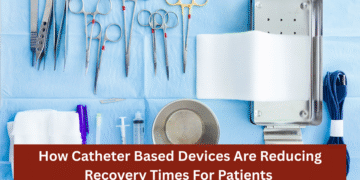Image from Unsplash
Digital transformation is advancing steadily within the medical sector, bringing streamlined workflows, improved procurement systems, and optimized patient care. While industries such as finance and retail often receive attention for technological innovation, healthcare, particularly clinical and dental practices, has been undergoing a quiet but meaningful digital evolution. For example, My DDS Supply offers dental professionals a streamlined online ordering experience for supplies, reflecting the broader shift toward digital infrastructure in clinical environments.
From electronic records and telehealth to automated procurement platforms, healthcare operations are becoming more efficient, data-driven, and patient-centric. These changes are not dramatic in presentation but significant in their impact.
Progression of Digital Tools in Clinical Environments
The healthcare industry traditionally adopts new technology at a slower pace due to regulatory, safety, and privacy concerns. However, increasing operational demands and the COVID-19 pandemic accelerated the adoption of digital tools. Clinics, hospitals, and dental offices now rely on digital systems not only to manage appointments and records but also to enhance communication, logistics, and treatment outcomes.
Electronic Health Records (EHRs), cloud-based communication platforms, and diagnostic imaging software are now standard tools in many clinical environments. These technologies are reshaping workflows, increasing productivity, and improving coordination across departments.
Enhancing Backend Operations Through Digitization
Although telemedicine is one of the most visible aspects of healthcare digitization, substantial improvements are occurring in backend systems. Inventory and supply chain management, for instance, has benefited from digitized dashboards and automated procurement workflows.
Suppliers like My DDS Supply exemplify this advancement. By offering real-time inventory updates, online order tracking, and digital invoices, these platforms eliminate manual processes, reduce ordering errors, and allow medical professionals to focus more on patient care than administrative logistics.
Integration of Electronic Health Records (EHRs)
EHRs are a core component of healthcare’s digital shift. These systems allow providers to maintain detailed and secure patient records, streamline diagnosis and treatment planning, and ensure consistency across multidisciplinary teams.
Interoperability is also improving. When systems are capable of securely exchanging data, healthcare providers gain a clearer understanding of patient histories, allergies, medications, and prior treatments. According to the Office of the National Coordinator for Health Information Technology (ONC), over 90% of office-based physicians in the United States currently use EHR systems, signifying broad industry adoption.
Workflow Automation and Administrative Efficiency
Administrative processes are being enhanced through automation. Clinics and dental practices now use software for tasks such as appointment scheduling, patient intake, and post-visit follow-up. Integration with EHRs allows for smoother data collection and management.
Key areas where automation is making an impact include:
- Insurance verification and claims processing
- Patient reminders and no-show reduction
- Digital intake forms and real-time data capture
- Smart scheduling based on historical trends
These systems contribute to operational consistency and reduce administrative burden, improving the overall patient experience.
Streamlined Procurement and Inventory Control
Image from Unsplash
Procurement technology is improving how clinics manage essential supplies. Manual processes are being replaced by software that monitors stock levels, generates reorders, and flags product recalls or expirations.
For example, platforms like My DDS Supply enable dental professionals to place and manage orders online, track usage, and take advantage of automated restocking. Clinics benefit from:
- Real-time inventory visibility
- Reduced stockouts and overstocking
- Simplified budgeting and cost analysis
Digital procurement also supports better supplier relationships, with access to order histories, shipment tracking, and compliance documentation.
AI-Powered Diagnostic and Support Tools
Artificial Intelligence (AI) is playing a growing role in diagnostics and clinical support. In dentistry, AI is used to analyze radiographs and detect conditions such as early-stage cavities or periodontal issues. These tools enhance clinical accuracy and assist in decision-making.
Beyond diagnostics, AI is also used in triage chatbots, risk assessment, and workflow optimization. These technologies contribute to faster patient processing and more personalized treatment recommendations.
Strengthening Cybersecurity in Healthcare Systems
As more healthcare operations move online, cybersecurity has become a top priority. Medical records are a frequent target of cyber threats, and systems must ensure data protection at every stage.
Current best practices include:
- End-to-end encryption
- Multi-factor authentication
- Role-based access controls
- Staff training on digital hygiene
Even non-clinical platforms that handle procurement and financial transactions, implement secure data protocols to protect sensitive business operations.
Overcoming Challenges of Digital Integration
Adopting digital tools in clinical settings can present challenges, particularly in terms of staff training and system compatibility. Resistance may stem from unfamiliarity or concern about workflow disruptions.
Effective integration requires:
- Comprehensive staff onboarding
- Ongoing technical support
- Clear protocols and feedback mechanisms
Successful implementation depends on the adaptability of the workforce and the user-friendliness of the technology.
The medical and dental sectors are advancing through incremental but impactful digital transformation. From recordkeeping and diagnostics to procurement and cybersecurity, digital tools are reshaping how clinics operate.
This transition is improving efficiency, accuracy, and patient outcomes. Platforms like My DDS Supply demonstrate how digital procurement is becoming a standard in clinical practice. As technology continues to evolve, healthcare providers will benefit from continued innovation that supports both operational excellence and quality of care.













